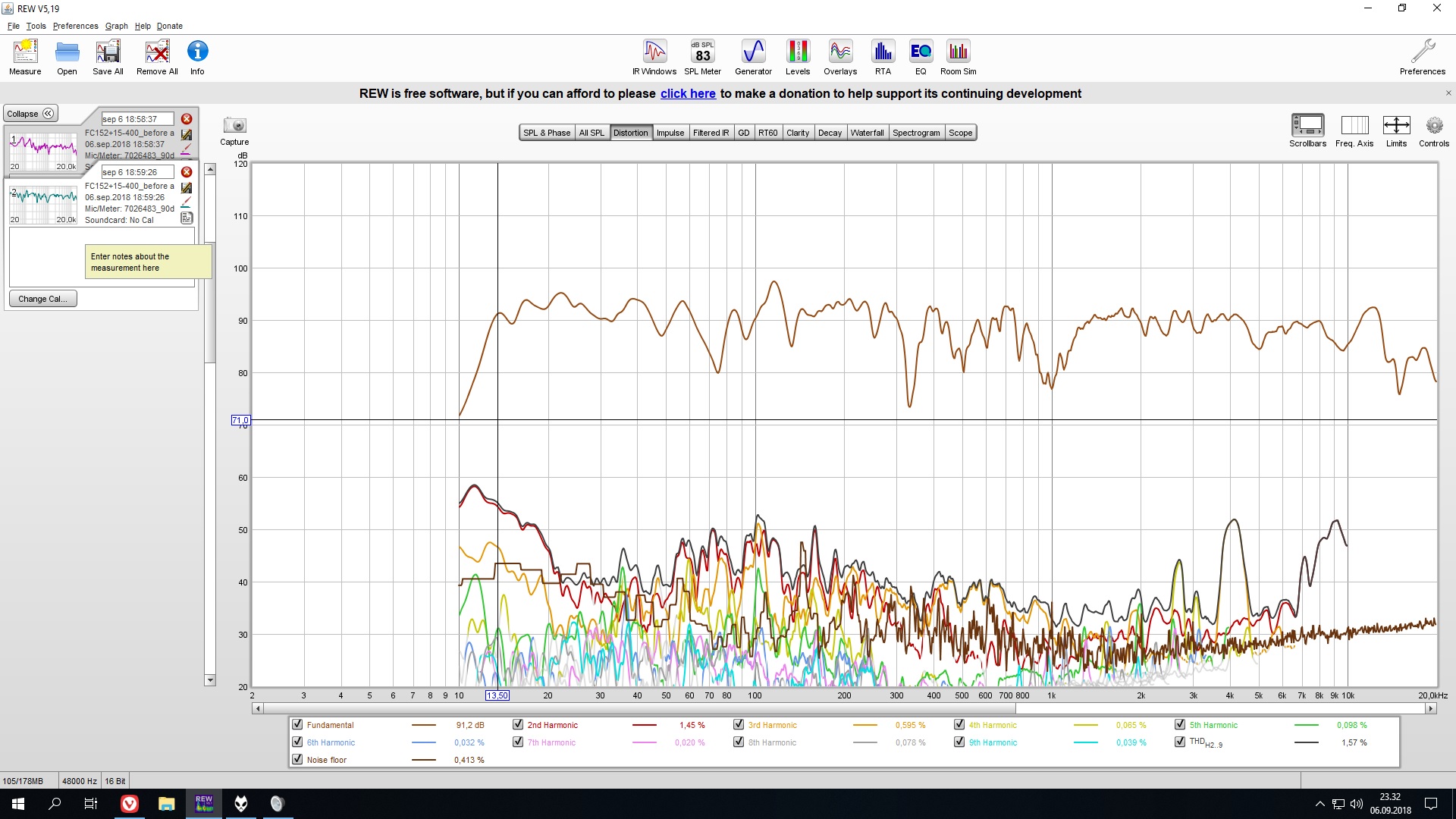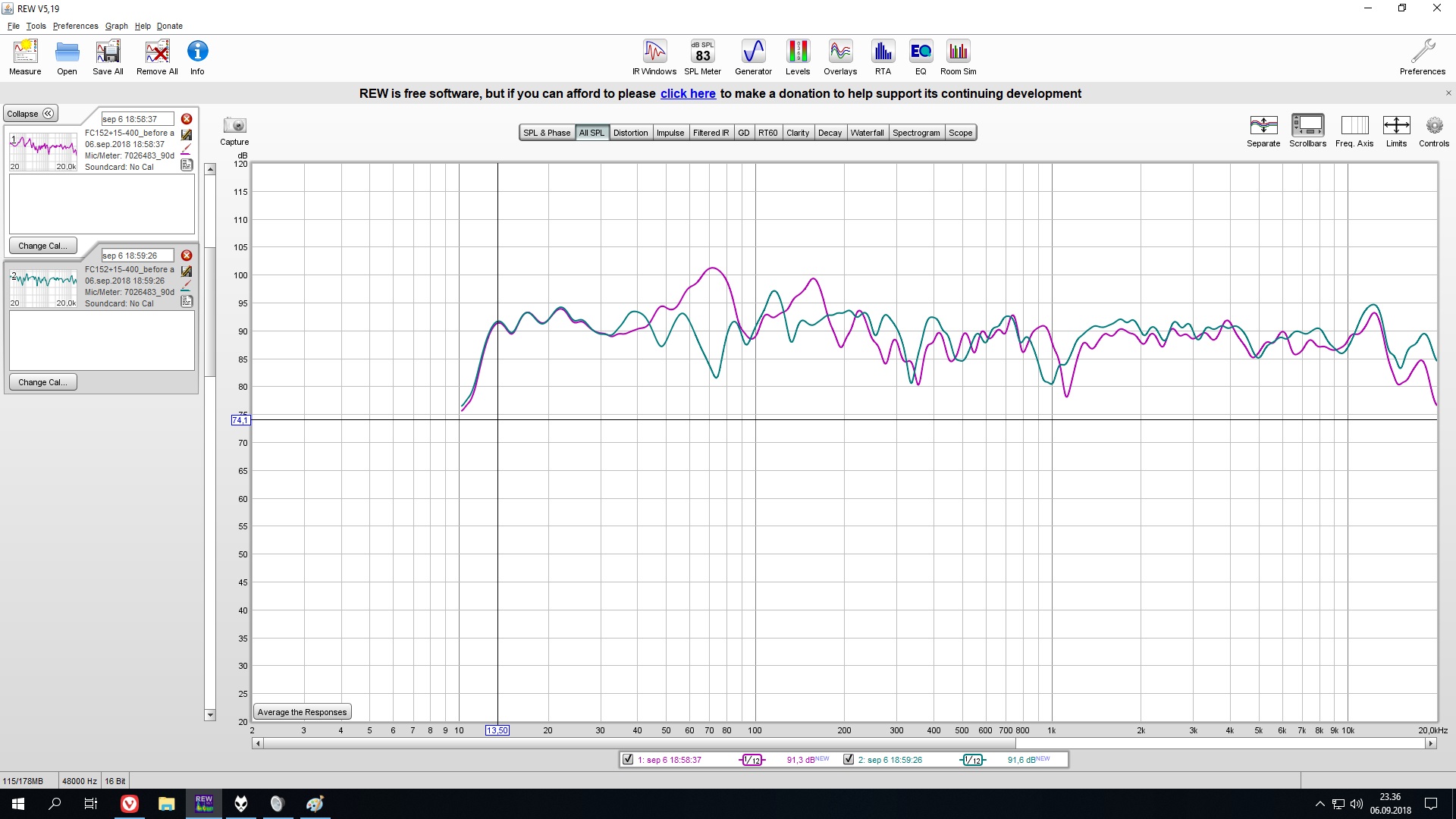oohms,20hz and below is tactile - you feel it as opposed to hear it
And no - you won't hear 20hz or below, only distortion and induced vibration from it
As was pointed out about a dozen years ago (before all my hair turned grey..) in posts #52 & 53, the average person only needs around 74 dB SPL to hear 20 Hz.
YOU may not be able to hear 20 Hz at that level, but there are plenty of us that can, and don't require harmonic distortion or tactile vibration to hear the fundamental frequency.
YOU may not be able to hear 20 Hz at that level, but there are plenty of us that can, and don't require harmonic distortion or tactile vibration to hear the fundamental frequency.
Yeah, we heard, then experienced <16 Hz/120+ dB when it cracked wall board joints and the ceiling rained down on us plus cracked loose a concrete block constructed floor support in the crawl space.
GM
Tell me more.....Got flat response to 13hz in-room, unexpected bonus.
Was aiming for slow roll off to 26hz.
Measured about 1.5% distortion at 13.5hz, which is about the highest distortion in the useable frequency range.
It's in my way to long and slightly ridiculous plan + build thread.
Budget 40-10k+hz 100db/w planning
Here's a link to the measured distortion picture.

And here's the difference between left/right channel.

It's in my way to long and slightly ridiculous plan + build thread.
Budget 40-10k+hz 100db/w planning
Here's a link to the measured distortion picture.
And here's the difference between left/right channel.
Please post your evidence, such as an RTA.On the Enya track “Longships” there is a drum fundamental at 12Hz that is completely lost without a true subwoofer.
No, you can’t hear these frequencies, but you can feel them as a “shudder” in the air around you. No, they are technically not audio, but I consider them to be a desirable part of music.
Amd no, they don’t have to be “loud” to be appreciated.
At those frequencies, they do have to be loud enough to sense in order to be appreciated unless you are talking about non-sensory experiences.
In studying my 17-foot labyrinth, I spent a lot of time watching REW supply low and sub-sonic test tones and watching as my mic recorded their loudness. So I can verify that low notes have to be monumentally louder than mid-range tones to a mic to match their perceived volume.
BTW, the arguments about low notes on a piano are mostly red herrings. The lowest notes do have some lesser amounts of fundamental tone but what you hear is largely the partials. Likely zilch fundamental coming out of the sound system for an electronic keyboard.
B.
Last edited:
On the Enya track “Longships” there is a drum fundamental at 12Hz that is completely lost without a true subwoofer.
No, you can’t hear these frequencies, but you can feel them as a “shudder” in the air around you. No, they are technically not audio, but I consider them to be a desirable part of music.
Amd no, they don’t have to be “loud” to be appreciated.
Excellent description
As always, there is a big difference in the final obejtivos of people.
There are people who love to listen and enjoy live music. I include myself in this sector. And since we can not live in a concert hall or in any other scenario, in our " home sweet home" (?)
But, also a very important sector of people (mostly connoisseurs or enthusiasts of the electronic and / or acoustic schools) plunge decidedly in search of technological perfection to achieve those objectives.
Well, each one invests his time in what he likes most ....
Or not ? I think you have to educate the "audiophile" and teach them to "separate the straw from the wheat", bring them closer to the music lover, who in the end is the one who does not know about electronics but has a lot of experience with their ears. (Golden ears are a pathological group not included in this reasoning) The auditory memory does not exist, but there is experience, any musician can tell you when an instrument is out of tune and sounds bad.
Last edited:
Given that an oscilloscope trace is not a way I'd ever try actually "seeing" a component of music playing let alone "measuring" it and let alone trying to share it with others, why don't you simply play a few minutes of that recording with an honourware REW cumulative RTA and post it?It was measured using an oscilloscope, there are no printouts or data.
Not for me to doubt the possibility of what you are saying. I've seen 16 Hz organ content albeit stuff nobody could ever hear at the level it was present in the recording (even if they could reproduce it). BTW, even big organs have trouble pumping out much sensible very low and sub-sonic content.
B.
The 12Hz signal I refer to on the track is strong and easy enough to see on a scope, I don’t know what the “honourware REW cumulative RTA” is that you are referring to, I tried searching for the term and got no result. You might give the track a listen yourself on a system that can reproduce that frequency if you don’t believe me, or perhaps someone else reading this thread who has experienced it can also chime in.
Last edited:
more usefull for the bass range or for identifying by ear any major peeks or nulls.
Online Tone Generator - generate pure tones of any frequency
Online Tone Generator - generate pure tones of any frequency
Last edited:
Measured about 1.5% distortion at 13.5hz, which is about the highest distortion in the useable frequency range.
It's in my way to long and slightly ridiculous plan + build thread.
Budget 40-10k+hz 100db/w planning
I thank you
Matt, hopefully it can be of some use.
The response between channels even out "nice enough", not the prettiest squiggly lines around, but I am not a believer of pretty squiggly lines. Makes me think something is missing. Do note that the measured response was with no xo at all, because I had severe issues implementing any crossover at all, tried so many tricks to get it right, eventually decided to try without.
The measured response was using 5 bands of EQ, and nothing more. Just to make the lines "pretty enough for presentation".
My day to day use involves 2-3 bands of EQ, sounds much better, but less pretty.
The response between channels even out "nice enough", not the prettiest squiggly lines around, but I am not a believer of pretty squiggly lines. Makes me think something is missing. Do note that the measured response was with no xo at all, because I had severe issues implementing any crossover at all, tried so many tricks to get it right, eventually decided to try without.
The measured response was using 5 bands of EQ, and nothing more. Just to make the lines "pretty enough for presentation".
My day to day use involves 2-3 bands of EQ, sounds much better, but less pretty.
+1, having experienced many large pipe organ recitals at several churches around Atlanta [one built with Ga. Marble], reflections makes for a highly entertaining experience that no sterile recording can begin to replicate, so IME the lower the tuning the more 'diversity' I want: Organs | Peachtree Road United Methodist Church
GM
GM
I think the most fun part for me, at least when big spaces like churches are involved in the recording, is that it actually feels like you are inside the room. It is like I get a sense of the air moving in the space around me. Close your eyes and you're there.
There is so much low level information at low frequencies, I think it is part of our spatial interpretation.
Most people never even consider it, but there is so much low frequency content in our surroundings. I've been pondering if that might be the reason we are less sensitive to low frequency signals during listening tests, that there is so much information already there, so the signal must be louder to stand out properly.
There is so much low level information at low frequencies, I think it is part of our spatial interpretation.
Most people never even consider it, but there is so much low frequency content in our surroundings. I've been pondering if that might be the reason we are less sensitive to low frequency signals during listening tests, that there is so much information already there, so the signal must be louder to stand out properly.
- Home
- Loudspeakers
- Subwoofers
- 10-25 Hz, is it necessary for HT or Music?